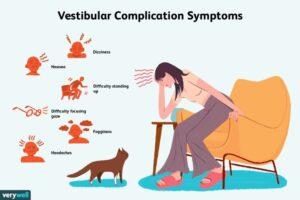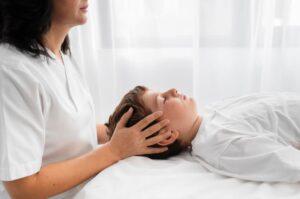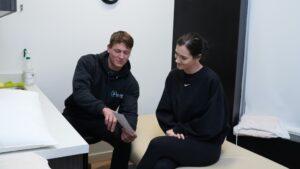Maintaining a sense of balance is crucial for our day-to-day activities, and any disruption in the vestibular system can lead to debilitating symptoms.
Vestibular rehabilitation therapy (VRT) is a specialized approach designed to address issues related to the inner ear and restore balance. In this post, we will delve into who can benefit from VRT, what triggers vestibular disorders, how long it takes for therapy to work, the success rate of VRT, common exercises prescribed by vestibular therapists, recommended frequency for exercises, and more. Let’s get into it!
Who can benefit from vestibular rehabilitation therapy?
Vestibular rehabilitation therapy is not limited to a specific age group; it can benefit individuals of all ages who experience vestibular system dysfunction. Common candidates include those suffering from:

- Vertigo: Intense spinning sensations that can be triggered by changes in head position.
- Dizziness: Persistent feelings of lightheadedness or unsteadiness.
- Balance Issues: Difficulty maintaining balance, especially during movement.
- Motion Sickness: Nausea or dizziness induced by motion, such as car rides.
- Post-Concussion Syndrome: Vestibular symptoms can persist after a concussion.
What triggers vestibular disorders?
Vestibular disorders can arise from various causes, including:
- Inner Ear Issues: Infections, inflammation, or damage to the inner ear can disrupt the vestibular system.
- Head Injuries: Trauma to the head can impact the vestibular organs and lead to dysfunction.
- Aging: Degeneration of the vestibular system can occur with age, affecting balance.
- Neurological Conditions: Certain neurological disorders can compromise the vestibular system.
- Medication Side Effects: Some medications may have vestibular-related side effects.
What is benign paroxysmal positional vertigo?
In the realm of vestibular disorders, benign paroxysmal positional vertigo (BPPV) is a common and treatable condition. BPPV is characterized by brief episodes of intense dizziness triggered by specific head movements. This disorder occurs when tiny calcium particles called canaliths clump together in the inner ear’s canals, disrupting the normal flow of fluid that helps maintain balance.
Symptoms of benign paroxysmal positional vertigo include: Sudden, brief episodes of vertigo with changes in head position, nausea, and unsteadiness or imbalance.
Triggers for BPPV include: Rolling over in bed, tilting the head back to look up, and quick head movements.
While benign paroxysmal positional vertigo often resolves on its own, vestibular rehabilitation therapy can expedite the process. Therapists may use specific maneuvers, such as the Epley maneuver, to guide the repositioning of displaced canaliths, aiming to move the particles out of the affected ear canal and alleviate symptoms. The duration of vestibular rehabilitation for BPPV varies, with many individuals experiencing relief after just one or two sessions.
How long does it take for vestibular rehabilitation to work?
The duration of vestibular rehabilitation therapy varies depending on the severity of the condition and individual factors. In many cases, patients start experiencing improvement within a few weeks. However, a complete recovery may take several months. Consistency and adherence to the prescribed exercises are crucial for optimal outcomes.
What is the success rate of vestibular rehabilitation?
The success rate of vestibular rehab is generally high, with many patients experiencing significant improvement in symptoms. Success depends on factors such as the specific vestibular disorder, the patient’s commitment to the exercises, and the expertise of the vestibular therapist. In cases where the underlying cause is treatable, addressing the root issue may lead to a more favorable outcome.
Exercises your vestibular therapist may recommend
Vestibular therapists employ a variety of exercises to improve balance and reduce symptoms. Common vestibular therapy exercises include:
- Gaze Stabilization Exercise: Focusing on a stationary object to enhance visual stability.
- Balance Training: Engaging in activities that challenge balance, such as standing on one leg or walking on uneven surfaces.
- Head Movement Exercise: Controlled movements of the head to desensitize the vestibular system.
- Habituation Exercise: Gradual exposure to movements or environments that provoke symptoms, helping the brain adapt over time.
- Eye-Head Coordination Exercise: Coordinating eye and head movements to enhance spatial awareness.
How many times a day should you do vestibular exercises?
The frequency of vestibular exercises depends on the individualized treatment plan created by your vestibular therapist during physical therapy. Typically, patients are advised to perform exercises multiple times a day. Consistency is key to maximizing the benefits of vestibular rehabilitation treatment. However, it’s essential to follow the therapist’s guidance, as overdoing exercises can be counterproductive.
FAQs on vestibular rehabilitation
Q: Is VRT painful?
A: Vestibular exercises are generally not painful. They are designed to be challenging but should not cause significant discomfort. If you experience pain during exercises intended to improve vestibular function, it’s important to communicate this to your therapist for adjustments.
Q: Can VRT be done at home?
A: Many vestibular rehabilitation exercises can be performed at home as part of a home exercise program. However, initial sessions are usually conducted in a supervised clinical setting.
Q: Are the benefits permanent?
A: With proper adherence to the prescribed exercises, many individuals experience lasting improvements. However, ongoing maintenance exercises may be recommended to sustain the benefits.
Q: Can VRT help with migraines?
A: Vestibular physiotherapy may be beneficial for some individuals with migraines, especially if vestibular symptoms are present. Consult with a healthcare professional to determine the most suitable treatment approach.
Schedule your vestibular rehabilitation therapy in Surrey, BC!
At Synergy Rehab we are proud to offer vestibular rehabilitation therapy—giving hope to those grappling with balance and vestibular dysfunction Whether you’re recovering from post concussion syndrome, dealing with an age-related balance disorder, or experiencing persistent vertigo, consulting with a vestibular therapist can provide personalized and life-changing solutions.
With dedication to the prescribed exercises and ongoing communication with your vestibular physiotherapist, the path to improved balance and well-being becomes a tangible reality! Book a same-day appointment with one of our expert physical therapists today. Let’s navigate movement and balance together.
Get back to your daily activity with ease.









